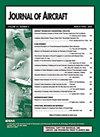利用飞越音频记录估算风扇转速
IF 2.1
3区 工程技术
Q2 ENGINEERING, AEROSPACE
引用次数: 0
摘要
飞机噪音排放通过影响人口健康和土地利用规划,影响世界各地的社会。这就需要能够以高精度预测这些类型的噪声排放的模拟工具。要达到令人满意的精度,一个至关重要的飞机参数是涡扇发动机低压轴的旋转频率,称为[公式:见文]。[公式:见文本]决定了发动机的功率使用,这里是根据地面麦克风的声学估计。提出了一种新的动态[公式:见文本]估计方法,与以前的方法相比,该方法具有更强的鲁棒性。它利用飞机不同的声音特性,将两种方法结合起来。第一种方法是在去多普勒声压谱图中跟踪多个风扇音调随时间的谐波。该频率跟踪任务采用动态规划求解,求出全局最优解。第二种方法与嗡嗡锯噪声有关,因此只适用于偏离。在倒谱域估计了蜂鸣声锯基频。两个子方法分别通过并发声压测量和飞行甲板记录数据进行验证和评估[公式:见文]。新的鲁棒估计方法将应用于噪声测量活动,以改进现有的飞机噪声排放模型。本文章由计算机程序翻译,如有差异,请以英文原文为准。
Estimation of the Fan Rotational Speed Using Flyover Audio Recordings
Aircraft noise emissions affect societies around the world by impacting the population’s health and land use planning. This calls for simulation tools able to predict these types of noise emissions with high accuracy. A crucial aircraft parameter to achieve satisfying precision is the rotating frequency of the low-pressure shaft of the turbofan engine, called [Formula: see text]. [Formula: see text] determines the engine’s power use and is here estimated acoustically from ground-based microphones. A new method for dynamic [Formula: see text] estimation is presented, which is more robust as compared to earlier approaches. It makes use of different aircraft sound characteristics and combines two methods. The first method tracks multiple fan tone harmonics over time within a de-Dopplerized sound pressure spectrogram. This frequency-tracking task is solved by dynamic programming to find the global optimum. The second method relates to buzz-saw noise, and is thus applied to departures only. The buzz-saw fundamental frequency is estimated in the cepstral domain. Both submethods are separately validated and assessed with concurrent sound pressure measurements and flight deck recording data of [Formula: see text]. The new robust [Formula: see text] estimation method will be applied in noise measurement campaigns with the goal of improving current aircraft noise emission models.
求助全文
通过发布文献求助,成功后即可免费获取论文全文。
去求助
来源期刊

Journal of Aircraft
工程技术-工程:宇航
CiteScore
4.50
自引率
31.80%
发文量
141
审稿时长
6 months
期刊介绍:
This Journal is devoted to the advancement of the applied science and technology of airborne flight through the dissemination of original archival papers describing significant advances in aircraft, the operation of aircraft, and applications of aircraft technology to other fields. The Journal publishes qualified papers on aircraft systems, air transportation, air traffic management, and multidisciplinary design optimization of aircraft, flight mechanics, flight and ground testing, applied computational fluid dynamics, flight safety, weather and noise hazards, human factors, airport design, airline operations, application of computers to aircraft including artificial intelligence/expert systems, production methods, engineering economic analyses, affordability, reliability, maintainability, and logistics support, integration of propulsion and control systems into aircraft design and operations, aircraft aerodynamics (including unsteady aerodynamics), structural design/dynamics , aeroelasticity, and aeroacoustics. It publishes papers on general aviation, military and civilian aircraft, UAV, STOL and V/STOL, subsonic, supersonic, transonic, and hypersonic aircraft. Papers are sought which comprehensively survey results of recent technical work with emphasis on aircraft technology application.
 求助内容:
求助内容: 应助结果提醒方式:
应助结果提醒方式:


